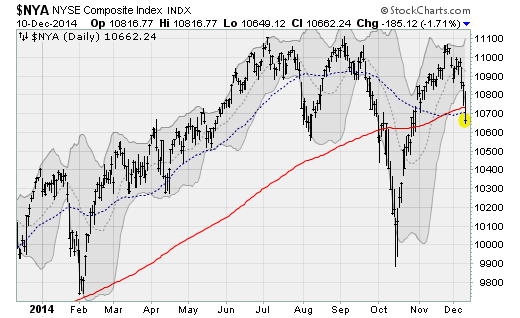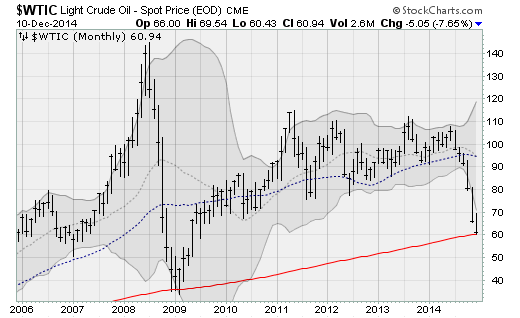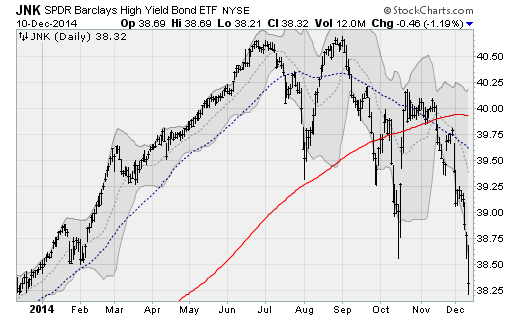What's blowing away 2014's "Santa Claus rally"
Well, it's finally happened.
The historic, unprecedented market uptrend out of the Oct. 15 low -- in which the S&P 500 closed above its five-day moving average for a record 29 days straight -- has ended. The NYSE Composite Index, my preferred gauge of the stock market, has sliced below both its 50-day and 200-day moving averages in one fell swoop on Wednesday. It has tipped into a fresh downturn for the first time since September.
And sliding along with it are hopes for the typical "Santa Claus" rally to finish the year out strongly.
Many moving parts are in play, from wild stock market volatility in China to political drama in Washington and the worst stock market decline since 1987 in Greece. Japan is suffering currency volatility heading into snap elections after falling into a quadruple-dip recession on weaker-than-expected third-quarter GDP numbers. Plus, we have the upcoming Federal Reserve policy meeting next week, with chatter circulating that the first interest rate hikes since 2006 could be coming within the next six months.
Like I said, lots of moving parts.
But above all, it's what's happening with crude oil and the impact it's having on credit markets as fears grow over the solvency of deeply indebted, high-cost U.S. shale oil producers. Back in November, I warned that the decline in energy prices may have unintended consequences. Those consequences are now in play.
Crude oil dropped below $61 a barrel, down 43% from its summertime highs, following a cavalcade of bearish headlines:
- OPEC's monthly oil report showed that global demand for its oil in 2015 would be weaker than expected due to U.S. production and restrained consumption, which it expects to drop to the lowest level since 2003.
- When asked whether OPEC should reduce production at its next scheduled meeting in June, Saudi Oil Minister Ali al-Naimi replied: "Why should we cut production?" That's a clear confirmation the kingdom won't act until U.S. producers scale back.
- Crude inventories rose 1.5 million barrels in the week ending Dec. 5 according to the U.S. Department of Energy. Analysts were looking for a drop of 2.7 million barrels.
- The American Petroleum Institute reported that U.S. oil stockpiles increased by 4.4 million barrels vs. expectations for a draw-down of 2.2 million barrels.
- And finally, late in Wednesday's session, OPEC announced that it may hold an emergency meeting in the first quarter of 2015 -- meaning that all this is set to continue for at least another month.
At first, the meltdown in crude was celebrated as great news for beleaguered U.S. consumers who've been waiting years for an increase in inflation-adjusted take-home pay. While wage growth remains tepid, a drop in pump prices is set to pad Americans' wallets heading into the holiday shopping season: According to Credit Suisse estimates, the drop in gasoline since July is worth a savings of about $1,000 a year for a household with an annual income of $40,000. That 2.5 percent boost to income is nothing to sneeze at.
But investors are starting to realize that the collapse in energy prices is about to have very serious consequences for corporate earnings (given the S&P 500's exposure to the energy sector), GDP growth (given the energy sector's importance to overall capital expenditures) and the credit markets (given that high-yield borrowing has become increasingly concentrated in shale-oil producers over the last few years).
This realization is clearly visible in the chart above of the Barclays High Yield Bond ETF (JNK), which has sliced into the red year-to-date after returning to levels not seen since last December.
Until crude oil can stabilize, at the very least, it looks like the pressure hitting stocks will only intensify.
The key thing to watch will be the impact on popular currency carry trades that hedge funds and other institutional traders have piled into. They're primed for pain: According to Bank of America (BAC), hedge funds are carrying the largest exposure to the yen carry trade in 10 years and are carrying the most exposure to stocks in six months.
The situation is ripe for some panic selling and a quick return to the mid-October lows -- not exactly the kind of finish to 2014 the bulls were looking for.



